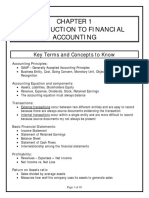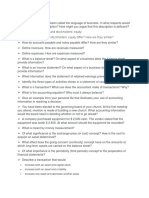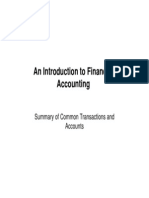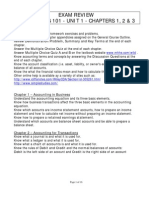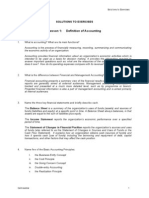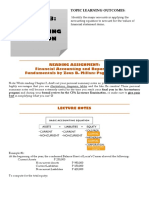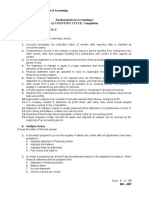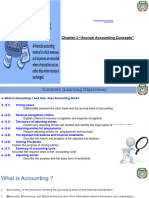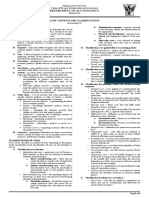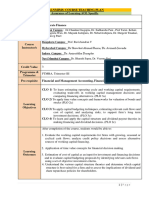BAC 101
CHAPTER 1
DISCUSSION QUESTIONS
10. Accounting is described as a service activity because it serves decision makers by
providing information to help them make better business decisions.
14. Accounting principles consist of (a) general and (b) specific principles. General
principles are the basic assumptions, concepts, and guidelines for preparing
financial statements. They stem from long-used accounting practices. Specific
principles are detailed rules used in reporting on business transactions and events.
They usually arise from the rulings (such as Statements of Financial Accounting
Standards from the FASB) of authoritative and regulatory groups.
16. This treatment is justified by both the cost and going-concern principles.
17. The revenue recognition principle provides guidance that managers and auditors
need for knowing when to recognize revenue. If revenue is recognized too early, the
income statement reports income earlier than it should and the business looks more
profitable than it is. On the other hand, if revenue is recognized too late, the prior
periods income statement shows lower amounts of revenue and net income than it
should and the business looks less profitable than it is. This principle requires
revenue to be recognized when it is both earned and can be measured reliably. The
amount of revenue should equal the value of the assets received (and expected to be
received) from the businesss operating activities covering a specific time period.
20. (a) Assets are probable future economic benefits obtained or controlled by an entity
as a result of past transactions or events. (b) Liabilities are probable future
sacrifices of economic benefits arising from present obligations of an entity to
transfer assets or provide services to other entities in the future as a result of past
transactions or events. (c) Equity is the residual interest in the assets of an entity
that remains after deducting its liabilities. (d) Net assets refer to equity.
Quick Study 1-2 (10 minutes)
(a)
GAAP:
Generally Accepted Accounting Principles
Importance: GAAP are the rules that specify acceptable accounting
practices.
SEC:
Securities and Exchange Commission
Importance: The SEC is charged by Congress to set reporting rules for
organizations that sell ownership shares to the public. The
SEC delegates part of this responsibility to the FASB.
�FASB:
Financial Accounting Standards Board
Importance: FASB is an independent group of full-time members who are
responsible for setting accounting rules.
(b)
The international accounting standards setting organization is
the International Accounting Standards Board (IASB). Its
purpose is to issue standards that identify preferred practices
in the desire of harmonizing accounting practices across
different countries. The vast majority of countries and
financial exchanges support its activities and objectives.
Quick Study 1-5 (10 minutes)
(a)
(b)
Examples of business transactions that are measurable include:
Selling products and services.
Collecting funds from dues, taxes, contributions, or
investments.
Borrowing money.
Purchasing products and services.
Examples of business events that are measurable include:
Decreases in the value of securities (assets).
Bankruptcy of a customer owing money.
Technological advances rendering patents (or other assets)
worthless.
An act of God (casualty) that destroys assets.
Exercise 1-1 (10 minutes)
a.
b.
c.
d.
e.
f.
g.
Corporation
Sole proprietorship
Corporation
Partnership
Sole proprietorship
Sole proprietorship
Corporation
Exercise 1- 8 (10 minutes)
a.
b.
c.
$95,000
$67,000
$112,000
�Exercise 1-12 (30 minutes)
Cash
a.
+$50,000
b.
_______
48,400 +
d. +
Bal.
e.
f.
50,400 +
8,000
Bal.
g.
42,400 +
2,400
Bal.
40,000 +
h. +
Bal.
i.
j.
Bal.
5,000 45,000 +
12,000
Bal.
33,000 +
10,000 =
12,000
22,000 =
______
50,400 +
Bal.
2,000
_______ +
500
$32,500 +
Accounts
= Payable +
+
$7,000
7,000 +
______ +
7,000 +
______
8,000
______
5,000
______
2,000 +
30,000 =
______
12,000 +
_______
12,000 +
_______
12,000 +
_______
30,000 =
30,000 =
2,000 +
+$12,000
22,000 =
7,000 +
______
22,000 =
______
______
12,000 +
_______
12,000 +
_______
12,000 +
12,000
30,000 =
______
Maben,
Capital
Maben,
Withdrawals + Revenue
- Expenses
+ $60,000
______
48,400 +
Bal.
Equipment
+ $10,000 =
1,600
Bal.
c.
Accounts
+ Receivable +
0 +
_______
$2,000 + $30,000 = $
______
$1,600
60,000
1,600
______
_____
60,000
______
60,000
2,000
1,600
______
7,000
_____
60,000
9,000
1,600
_____
_____
9,000
1,600
______
60,000
______
_____
2,400
9,000
4,000
_____
_____
9,000
4,000
_____
_____
9,000
4,000
$500
_____
_____
$500 +
$9,000
$4,000
______
60,000
______
60,000
0 + $60,000
_____
60,000
______
$2,000
1,600
�Problem 1-1A (40 minutes)Part 1
Company A:
(a)
Equity on December 31, 2004:
Assets.......................................................... $45,000
Liabilities..................................................... (23,500)
Equity.......................................................... $21,500
(b)
Equity on December 31, 2005:
Equity, December 31, 2004........................ $21,500
Plus owner investments............................
5,000
Plus net income..........................................
7,500
Less owners withdrawals......................... (2,500)
Equity, December 31, 2005....................... $31,500
(c)
Amount of liabilities on December 31, 2005:
Assets.......................................................... $48,000
Equity.......................................................... (31,500)
Liabilities..................................................... $16,500
Part 2
Company B:
(a) and (b)
�Equity:
12/31/2004 12/31/2005
Assets................................... $35,000
$41,000
Liabilities.............................. (22,500)
(27,500)
Equity
$12,500
$13,500
c)
Net income for 2005:
Equity, December 31, 2004..................... $12,500
Plus owner investments.........................
1,500
Plus net income.......................................
?
Less owners withdrawals...................... (3,000)
Equity, December 31, 2005..................... $13,500
Therefore, net income must have been $2,500.
Part 3
Company C:
First, calculate the beginning balance of equity:
Dec. 31, 2004
Assets.......................................................... $29,000
Liabilities..................................................... (14,000)
Equity.......................................................... $15,000
Next, find the ending balance of equity by completing this table:
Equity, December 31, 2004........................ $15,000
Plus owner investments............................
7,750
Plus net income..........................................
9,000
Less owners withdrawals......................... (3,875)
Equity, December 31, 2005........................ $27,875
Finally, find the ending amount of assets by adding the ending balance of
equity to the ending balance of liabilities:
Dec. 31, 2005
Liabilities..................................................... $19,000
�Equity..........................................................
27,875
Assets....................................
$46,875
Part 4
Company D:
First, calculate the beginning and ending owners equity balances:
12/31/2004 12/31/2005
Assets...................................... $80,000
$ 125,000
Liabilities................................. (38,000)
(64,000)
Owners Equity....................... $42,000
$ 61,000
Then, find the amount of owner investments during 2005:
Equity, December 31, 2004.......................... $42,000
Plus owner investments...............................
?
Plus net income............................................ 12,000
Less owner withdrawals..............................
0
Equity, December 31, 2005.......................... $61,000
Thus, owner investments must have been:
$7,000
Part 5
Company E:
First, compute the balance of equity as of December 31, 2005:
Assets.......................................................... $112,500
Liabilities.................................................... (75,000)
Equity.......................................................... $ 37,500
Next, find the beginning balance of equity as follows:
Equity, December 31, 2004........................ $
?
Plus owner investments............................
4,500
Plus net income.......................................... 18,000
�Less owners withdrawals......................... (9,000)
Equity, December 31, 2005....................... $37,500
Thus, the beginning balance of equity was $24,000.
Finally, find the beginning amount of liabilities by subtracting the beginning balance of
equity from the beginning balance of assets:
Dec. 31, 2004
Assets.......................................................... $123,000
Equity.......................................................... (24,000)
Liabilities.................................................... $ 99,000
Problem 1-7A (60 minutes) Parts 1 and 2
Assets
Date
Cash
Accounts
Receivable
=
Office
=
Equipment
May 1 +$60,000
1
Accounts
Payable
Equity
+ J.D. Simpson, - J.D. Simpson, +
Capital
Withdrawals
Revenues
$1,680
800
8 +
4,600
$4,600
3,000
15 -
850
20 +
3,000
22
25 +
2,800
26 -
1,680
$3,000
Expenses
$3,200
800
850
= + $1,680
12
$60,000
3,200
3
5
Liabilities +
3,000
2,800
2,800
=
= -
1,680
2,800
�27
= +
60
60
28 -
850
850
30 -
200
200
30 -
480
480
31 -
1,200
$6,440
$61,140
$1,680
60
$60,000
$1,200
$1,200
$10,400
�Part 3
THE SIMPSON CO.
Income Statement
For Month Ended May 31
Revenues
Consulting services revenue ............
$10,400
Expenses
Rent expense.......................................
Salaries expense.................................
Advertising expense...........................
Cleaning expense...............................
Telephone expense............................
Utilities expense..................................
Total expenses....................................
Net income..................................................
$3,200
1,700
60
800
200
480
6,440
$
3,960
THE SIMPSON CO.
Statement of Owners Equity
For Month Ended May 31
J.D. Simpson, Capital, May 1....................................
$
0
Plus: Owner Investments.....................................
60,000
Net Income.......................................................
3,960
63,960
Less: Owner Withdrawals.........................................
1,200
J.D. Simpson, Capital, May 31..................................
$62,760
THE SIMPSON CO.
Balance Sheet
May 31
Assets
Cash............................... $61,140
..........................$
60
Office equipment..........
1,680
Liabilities
Accounts payable...................
�Equity
J.D. Simpson, Capital.............
62,760
Total assets................... $62,820
equity............................. $62,820
Total liabilities and
�Problem 1-7A (Concluded)
Part 3
THE SIMPSON CO.
Statement of Cash Flows
For Month Ended May 31
Cash flows from operating activities
Cash received from customers................................
Cash paid for rent......................................................
Cash paid for cleaning...............................................
Cash paid for telephone............................................
Cash paid for utilities.................................................
Cash paid to employees............................................
Net cash provided by operating activities...............
$10,400
(3,200)
(800)
(200)
(480)
(1,700)
Cash flows from investing activities
Purchase of equipment.............................................
Net cash used by investing activities......................
(1,680)
Cash flows from financing activities
Investments by owner...............................................
Withdrawals by owner...............................................
Net cash provided by financing activities...............
60,000
(1,200)
Net increase in cash..................................................
Cash balance, May 1..................................................
Cash balance, May 31................................................
$ 4,020
(1,680)
58,800
$61,140
0
$61,140

